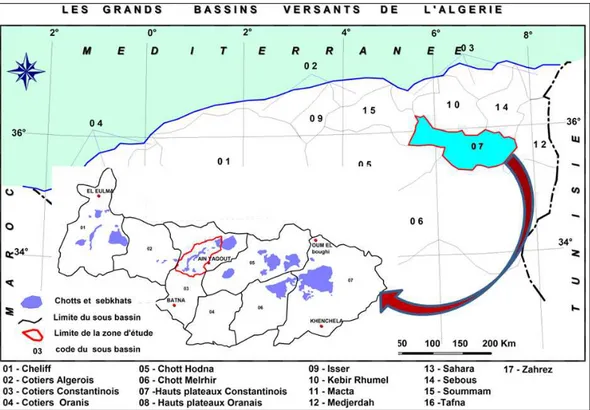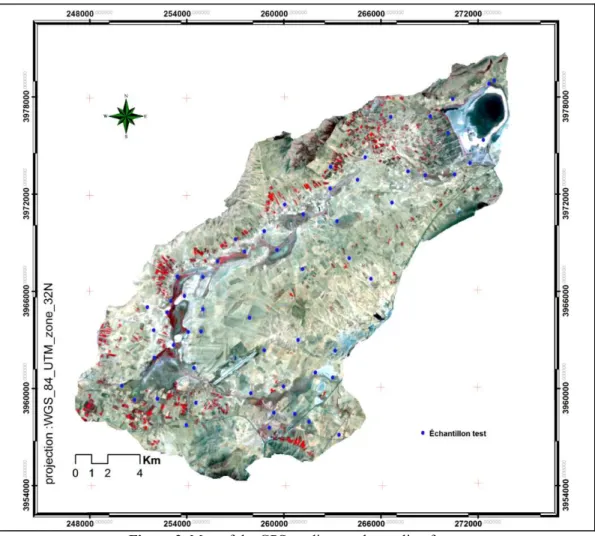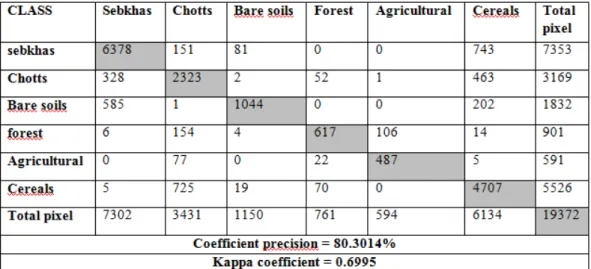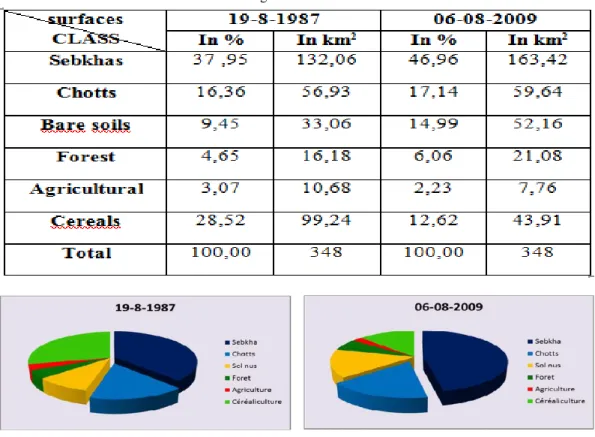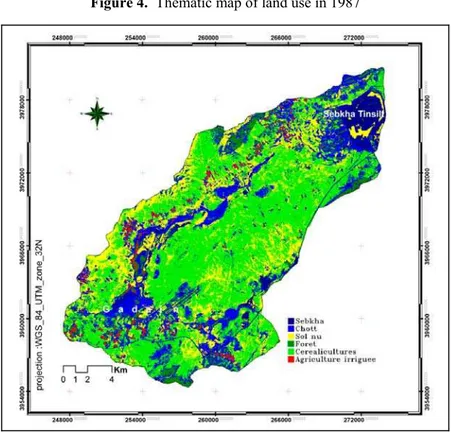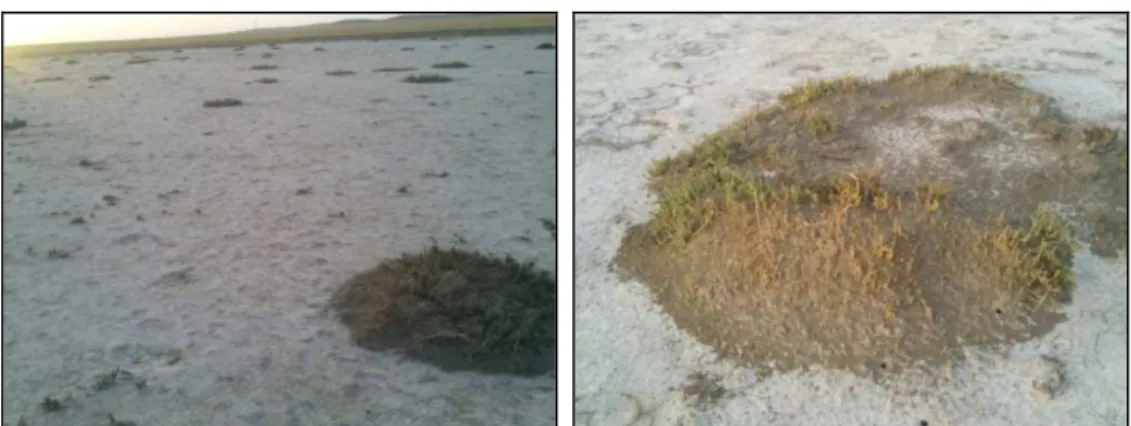ISSN 11445544--22774499, E-ISSN 22006655--11661199 Article no. 225522111100--669900
http://istgeorelint.uoradea.ro/Reviste/Anale/anale.htm
C
CO
ON
NT
TR
RI
IB
BU
UT
TI
IO
ON
N
O
OF
F
R
RE
EM
MO
OT
TE
E
S
SE
EN
NS
SI
IN
NG
G
I
IN
N
T
TH
HE
E
A
AN
NA
AL
LY
YS
SI
IS
S
O
OF
F
T
TH
HE
E
D
DY
YN
NA
AM
MI
IC
CS
S
O
OF
F
C
CH
HO
OT
TT
TS
S
A
AN
ND
D
S
SE
EB
BK
KH
HA
AS
S:
:
C
CA
AS
SE
E
O
OF
F
T
TH
HE
E
E
EN
ND
DO
OR
RE
EI
IC
C
A
AR
RE
EA
A
O
OF
F
G
GA
AD
DA
AI
IN
N
(
(N
NO
OR
RT
TH
HE
EA
AS
ST
T
O
OF
F
A
AL
LG
GE
ER
RI
IA
A)
)
R
RaabbaahhBBOOUUHHAATTAA
Université El Hadj Lakhdar, Laboratoire „risques naturels et aménagement du territoire” Batna, Algérie, e-mail: m_bouhata24@yahoo.fr
M
MaahhddiiKKAALLLLAA
Université El Hadj Lakhdar, Laboratoire „risques naturels et aménagement du territoire” Batna, Algérie, e-mail: m_kalla1@yahoo.fr
A
AiiddaaBBEENNSSEEKKHHRRIIAA
Université El Hadj Lakhdar, Laboratoire „risques naturels et aménagement du territoire” Batna, Algérie, e-mail: m_bouhata12@yahoo.fr
Abstract: The highlands of Eastern Algeria are characterized by an endorheism namely a local base level that does not allow the water system to get to the sea. The Area of chotts and sabkhas of Gadain region can be considered as an area of degradation lands due to the dynamics of sabkhas and chotts that are localized and installed on large areas on one hand and accelerated anthropogenic pressure on the other hand. This dynamic often presents special large extension, this study requires accurate and geo localized information's. The analysis of the dynamics of chotts and sabkhas based on medium resolution satellite images on two different dates (Landsat TM 1987 and TM 2009) specializes (mapping) and evaluates this dynamic. The comparison of the results provides an overview of the affected areas by the dynamics of sabkhas and chotts and their direction for 22 years.
Key words: Sebkha, chott, endorheic, dynamic, Gadain
* * * * * *
INTRODUCTION
The process of degradation of agricultural land by soil salinization is one of the desertification forms in Algeria and the world, where itself covers nearly 500 000 Ha / year according to the figures of FAO, 2005. It overlaps with endorheic arid and semi-arid areas. Recent studies on spatial sebkhas and chotts (Douaoui et al., 2007; Hachicha, 2007; Benchallal et al., 2009; Stephen et al., 2012) show some dynamic and expansion as a result of natural causes (topography, climate regime, ... etc.) on one hand and under human pressure on the others (Bouhata, 2015). The highland regions of eastern Algeria are characterized by a local base level endorheism that does not allow the water system to get to the sea. These endorheic areas of closed
or semi-closed morphological character localize receptors spaces and surface runoff collectors coming simultaneously from many basins. The interactions between these vulnerable areas, arid and semi-arid climate regime and socialization pressures directly contribute to the acceleration of ecosystem degradation process (Bouhata, 2015). The chotts and sebkhas area of Gadain region belongs to those areas and considered as an area of land degradation (salinization) due to the dynamic of chotts and sebkhas settled over large areas (Bouhata, 2008). This degradation leads to a new situation characterized by the decrease of agricultural land in a very fast way and it may reach an uncontrollable and irreversible threshold. Mapping of land use in this plain requires a synchronous study of surfaces and their uses. This study is based on a good knowledge of the existing land, that is why it is necessary to develop monitoring and management strategies of the environment and the agriculture, based on technological performance (Garouani et al.,1993; Benmessoud, 2011). The application of remote sensing has made it possible to study land use in less time, at lower cost and with a greater accuracy (Kachhwaha, 1985). Currently the Landsat satellite imagery is an important source of information for observing the earth surface due to its digital repetitive nature and also availability. The objective of this study is the analysis of the spatiotemporal evolution of land use, particularly the dynamics of sebkhas and chotts using the processing of two different Landsat satellite images dates (1987 and 2009).
PRESENTATION OF THE STUDY AREA
The study area is part of the southern Constantine high plains of eastern Algeria, which constitute a vast corridor mostly dominated by two mountains ranges: Aures massif to the south and Constantine mountains range to the north, a few kilometers north of Batna city. It is defined between the ranges of coordinates; Longitude: 6°12'15'' E and 6°29'50" E, Latitude: 35°55'51"N and 35°40'50" N. According to ANRH, it belongs to the watershed of Constantine high plains (07-03) (figure 1).
Located at an altitude of (784 m to 1246 m), the study area is characterized by an impressive platitude whose slope rarely exceeds 5%. The area is spread on a surface of (348 km2 )representing 46% of the total surface. This favors the presence of endorheism resulted in a multitude of Sebkhas and chotts that occupying the center of the plain (Ben Azzouz, 1986).
In geologic term, the presence quaternary formations (sebkha soil, salted lemons...etc) and Triassic formations (colorful marls and gypsum breccias), significantly contribute to the salt character of these endorheic spaces. Generally, due to the semi-arid climate we can only find steppe and halophytic species that are resistant to soil salinity, mostly presented by a characteristic vegetation of large clumps Artiplex or Salsolaceae (Bouhata, 2008).
MATERIALS AND METHODS
We used for this diachronic study two Landsat TM satellite images of 30x30 m resolution, the first dating (August 19th, 1987), the second dated (August 6th, 2009). The choice of this period coincide with very low vegetation cover and accumulation of salts on the soil surface after a long drought (Bouhata, 2015). Two images of equal dimensions (970 x 900 pixels) were extracted according to the above raw images. We opted for a color composite of channels 4, 3, 2, which allows us to identify the different units of Land Use cleanly compared to other colored compositions. Based on visual interpretations and also good knowledge of the reality on the ground, from several missions on field using a GPS to locate some parcels images (figure 2).
We defined six land cover classes (sebkha, Chott, bare soil, forest, agriculture and cereals). A supervised classification based on the method of maximum likelihood, was used on the previous two colored composition images using the image processing software (ENVI 4.5). This method is considered as a powerful technique for classification. The rule of the decision of this method is based on the probability of a pixel belonging to a given category (Fojstng, 1999) and (Omar, 2014).
Confusion matrix to validate the relevance and quality of our classifications (Benmessaoud et al., 2009; Bensaid, 2003), illustrate this performance (table 1 and 2); the average performance of classifications is 80.3% for the classification of TM 1987 and 85.2% for the classification of the TM 2009.
Table 1. Image classification confusion matrix TM 1987
Table 2. Image classification confusion matrix TM 2009
RESULTS AND DISCUSSIONS
Table 3. Percentage and surface of land use units
Figure 3. Comparison between surfaces occupancy units soil (1987-2009)
The observation and analysis of previous results show an extension in: sebkhas 9%, chotts 0.8%, and bare soils 5.5%; a regression of agricultural and cereals surfaces 16.5%, which indicates the phenomenon of land degradation and the decline of agricultural activities in this region. Visual analysis of thematic maps of the resulting soil occupancy of the two previous classifications (figure 4 and 5), allows us to compare the state of surface spatial occupation on one hand and analysis the dynamics of sebkhas and chotts on the other hand. We notice a big visible change concerns the surfaces of classes (sebkhas, bare soil and cereals) representing the largest surface in the study area between 1987 and 2009. These changes result from the interaction of climatic deterioration, the endorheic nature and the impact of rapid socialization of these vulnerable areas. The strong growth of sebkhas surfaces (over 30 km²) during 22 years is explained by the influence of human impact.
Figure 4. Thematic map of land use in 1987
The spreading and dynamics of sebkhas chotts surfaces correspond to a loss of agricultural land and increase the vulnerability of these areas to desertification problems in general. The field clues are shown in both (figure 7 and 8). And the results obtained by processing satellite images show the rapid appearance of the ecosystem degradation process.
Figure 6. Stagnant surface water on poorly constructed roadsides (Photoes taken by Bouhata)
Figure 7. The lateral dynamics of sebkhas and chotts
(Photoes taken by Bouhata, July 2013)
CONCLUSION
The degradation of farm land due to the dynamic of chotts and sebkhas is a major problem in all endorheic highlands areas of the eastern Algeria. The monitoring of this dynamic and its evaluation by conventional cartographic means remains difficult because of the update period which takes several months. For this reason, the mapping capabilities of Earth observation systems by satellites (Landsat) that provide regularly updatable and synchronic information have become indispensable. The study shows that surfaces of sebkhas and chotts catastrophically increased between summer 1987 and summer 2009 in the region of Gadain. This transgression is an indicator of a fast degradation of the ecosystem. It leads to an irreversible situation and very difficult to correct either on the local or regional scale of development, if not taken the immediate and necessary provisions that are based on the understanding and the analysis of the different ecosystem factors using the new geomatics techniques.
REFERENCES
Ben azzouzn M.T. (1986), Recherche géomorphologiques dans les hautes plaines de l’est algérien: la sebkha Tarf
(Algérie); thèse doctorat, Université de Paris 1 Sorbonne, France.
Benchallal A., Oukil A., Belhadj-aissa A. (2009), Identification et détection, par imagerie satellite, de la dégradation des sols par la salinité dans la cuvette d’Ouargla, sud Algérie, JAS09 de l'AUF Alger Novembre 2009.
Benmessaoud H., (2011), Use of images alsat1 for the implementation of maps land in semi-arid area - Case of the aurés
region (Algeria), Analele Universității din Oradea, Seria Geografie, Editura Universităţii din Oradea, Oradea Times (2011), pp. 16-22.
Benmessaoud H., Kalla M., Driddi H. (2009), Évolution de l’occupation des sols et désertification dans le sud des Aurès (Algérie), Mappemonde no. 94 -2.
Bensaid A., Smahib Z., Iftenect., Benzinehd S. (2003), Utilisation de la télédétection et dessig pour l'aide à la surveillance
du risque de dégradation des parcours steppiques, Télédétection, vol. 3, n° 5, p. 387–402.
Bouhata R. (2008), Analyse de la dynamique des sebkhas et son impact sur la vulnérabilité au risque d’inondation dans les dépressions endoréiques situées entre Zana et Madghassen à l’aide de l’imagerie satellitaire LANDSAT, Mémoire de magister- université Hadj Lakhdar Batna, p.160.
Bouhata R. (2015), use of landsat tm for mapping land use in the endorheic area - case of gadaine plain (eastern Algeria). Analele Universității din Oradea, Seria Geografie, Editura Universităţii din Oradea, Oradea, no. 2/2014 (December), pp. 101-107.
Bouhata R., (2015), Application des techniques de géomatique dans l’analyse de la vulnérabilité des zones endoréiques (Hauts Plateaux de l’Est Algérien - Case de la plaine de Gadaine et ses bordures), Thèse de doctorat en Aménagement du territoire, Université Hadj Lakhdar, 197 p.
Douaoui A., Hartani T. (2007), Impact de l’irrigation par les eaux souterraines sur la dégradation des sols de la plaine du Bas-Chéliff, Actes du troisième atelier régional du projet Sirma, Nabeul, Tunisie, 4-7 juin 2007.
Étienne L., Dahech S., Beltrando G., Daoud A. (2012), Dynamiques récentes des sebkhas littorales de l’archipel des kerkennah (tunisie centroméridionale: Apport de la télédétection.Télédétection, vol. 11, no. 1, pp. 273-281. Fojstng E., (1999), Contribution de la Morphologie mathématique à la cartographie de l’occupation du sol a partir
d’image SPOT (Région de l’extrême Nord-Cameroum), Rapport de doctoral en télédétection, Réseau télédétection, AUPELF - UREF, p. 91.
Garouani A. et al., (1993), Cartographie de l’occupation du sol et des zones humides par télédétection dans la basse vallée de la Medjerda (Tunisie), Cinquième journées scientifiques du réseau de la télédétection d’AUPELF - UREF, Tunisie, 21-24 Septembre 1993, p.163-170.
Hachicha M. (2007), Les sols salés et leur mise en valeur en Tunisie, Sécheresse vol. 18, no. 1, p 45-50.
Kachhwala T.S. (1985), Temporal monitoring of forest land for change detection and forest cover mapping through satellite remote sensing, Proceedings of the 6th Asian Conference on Remote Sensing Hyderabad, pp 77–83. Khalid Omar Murtaza, Shakil A. Romshoo (2014), Determining the Suitability and Accuracy of Various Statistical
Algorithms for Satellite Data Classification, International journal of geomatics and geosciences, Volume 4, No 4, pp 585-599.
*** (2015), Annuaire statistique de la FAO
